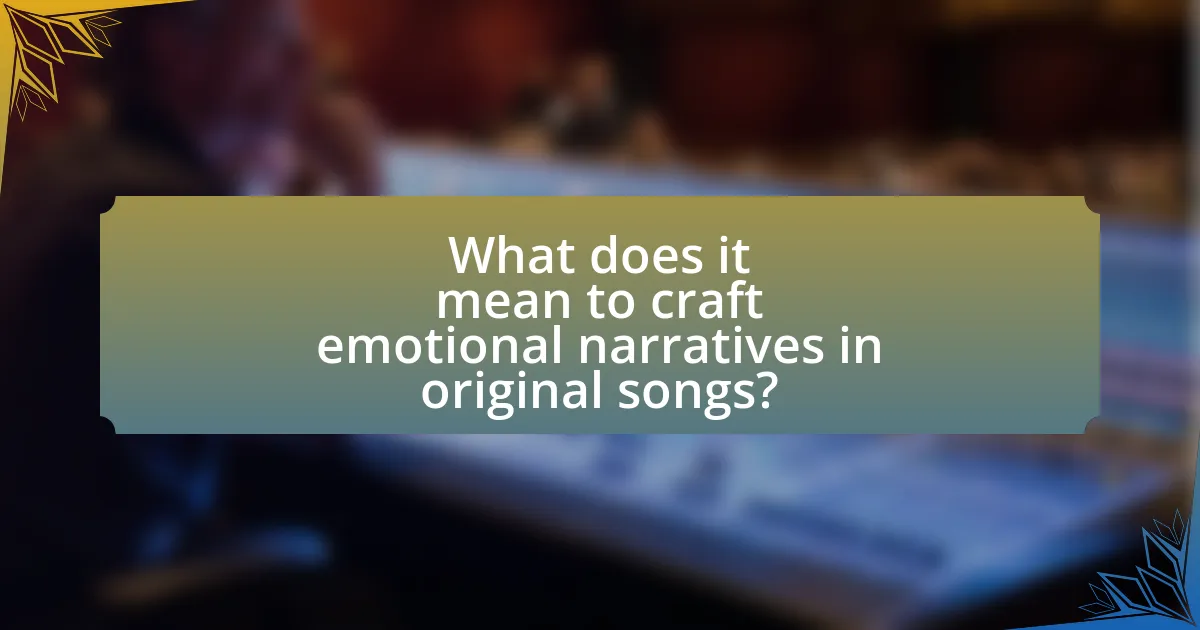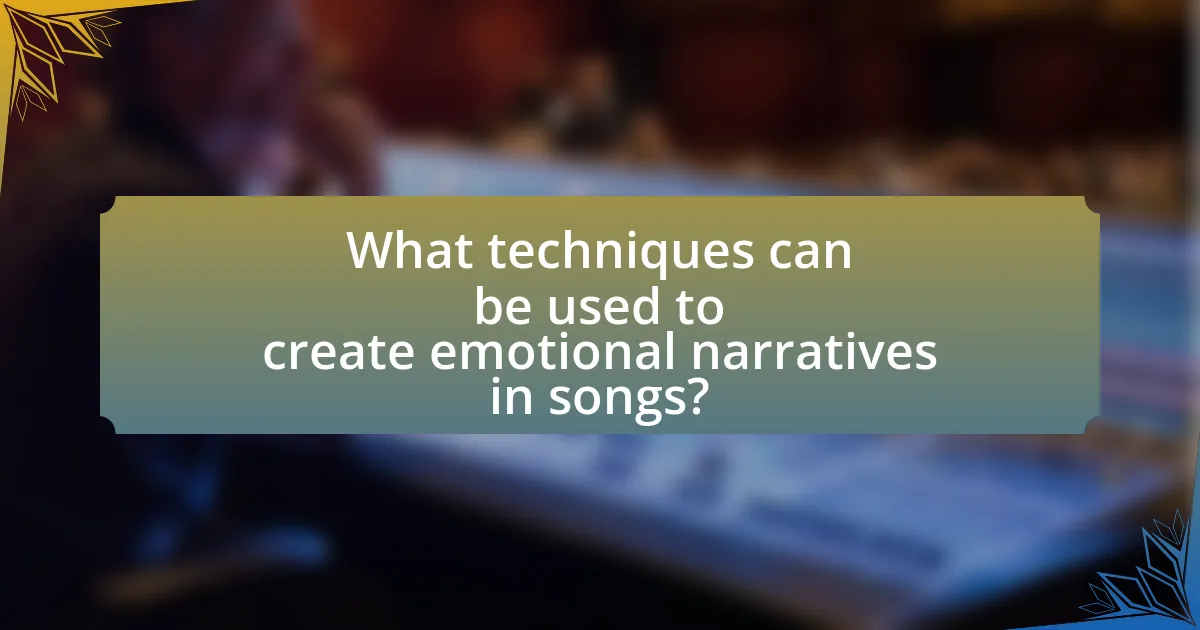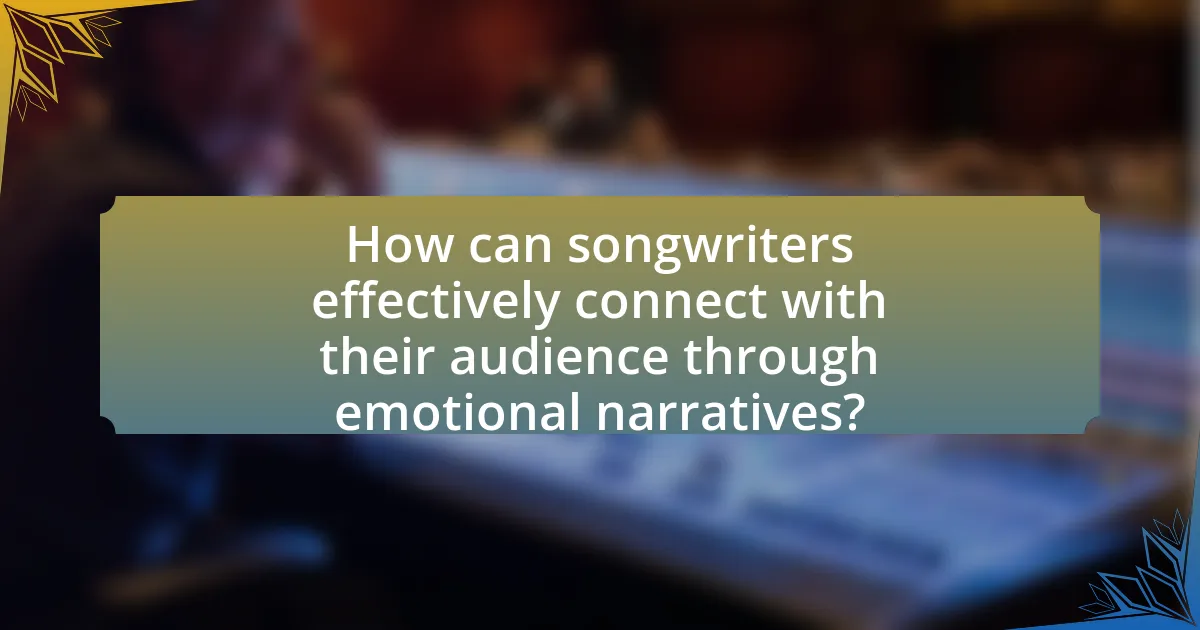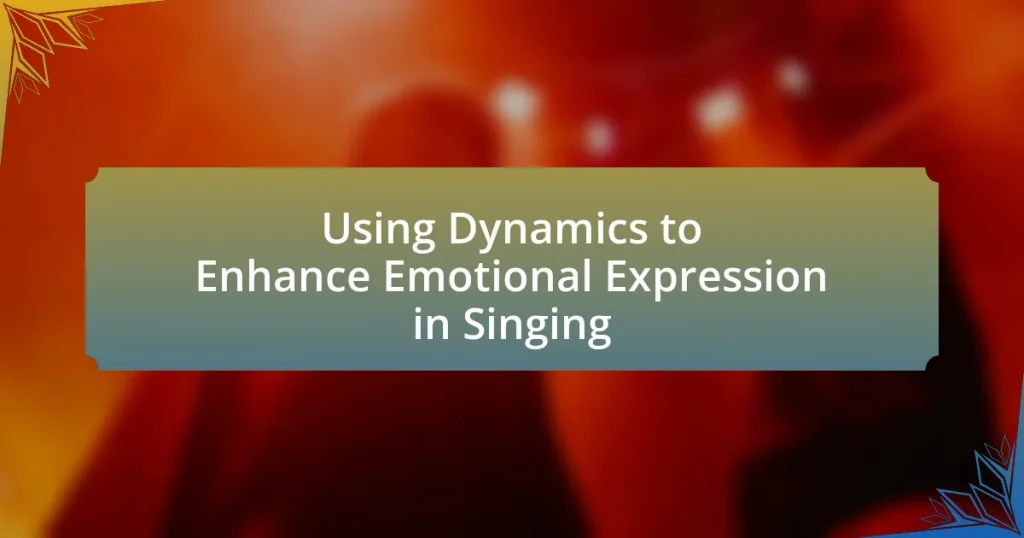Crafting emotional narratives in original songs involves creating relatable stories that evoke feelings and connect with listeners. This article explores the significance of emotional narratives in songwriting, highlighting how elements such as lyrics, melody, and personal experiences contribute to listener engagement and memory retention. It discusses the importance of storytelling, the role of imagery and metaphor, and the impact of song structure on emotional expression. Additionally, the article addresses strategies for evoking empathy, the benefits of sharing personal stories, and common pitfalls to avoid in order to enhance the emotional resonance of songs.

What does it mean to craft emotional narratives in original songs?
Crafting emotional narratives in original songs means creating stories that evoke feelings and connect with listeners on a personal level. This process involves using lyrics, melody, and structure to convey experiences, emotions, and themes that resonate with the audience. For example, a song that tells a story of heartbreak can use vivid imagery and relatable situations to elicit empathy and reflection from listeners, making the emotional impact more profound. Research indicates that songs with strong emotional narratives can enhance listener engagement and memory retention, as emotions play a crucial role in how we process and recall information.
How can emotional narratives enhance the listener’s experience?
Emotional narratives enhance the listener’s experience by fostering a deep connection between the audience and the story being told. This connection is achieved through the evocation of empathy, allowing listeners to relate their own feelings and experiences to the narrative. Research indicates that stories with emotional depth can activate brain regions associated with empathy and emotional processing, such as the anterior insula and the anterior cingulate cortex. For instance, a study published in the journal “Cognitive Science” by Paul Zak found that narratives that elicit strong emotional responses can increase oxytocin levels, which enhances feelings of trust and connection. Thus, emotional narratives not only engage listeners but also create a memorable and impactful experience that resonates on a personal level.
What elements contribute to an emotional narrative in songwriting?
Emotional narratives in songwriting are primarily shaped by lyrical content, melody, and personal experience. Lyrical content conveys relatable themes such as love, loss, or struggle, which resonate with listeners on a personal level. Melody enhances the emotional weight of the lyrics; for instance, minor keys often evoke sadness while major keys can inspire joy. Personal experience adds authenticity, as songwriters who draw from their own lives create a deeper connection with their audience. Research indicates that songs reflecting genuine emotions can lead to stronger listener engagement, as evidenced by studies showing that emotionally charged music can activate brain regions associated with empathy and emotional processing.
How do personal experiences shape emotional narratives?
Personal experiences shape emotional narratives by providing the foundational context and authenticity that resonate with listeners. These experiences influence the themes, emotions, and storytelling techniques used in songwriting, allowing artists to convey genuine feelings and relatable situations. Research indicates that emotional engagement in music is heightened when artists draw from their own life events, as listeners often connect more deeply with narratives that reflect real struggles or triumphs. For instance, a study published in the Journal of Music Therapy by Bradt and Dileo (2014) found that personal storytelling in music enhances emotional responses and fosters a sense of connection between the artist and the audience.
Why is storytelling important in songwriting?
Storytelling is important in songwriting because it creates emotional connections between the artist and the listener. When songwriters weave narratives into their lyrics, they engage the audience’s imagination and evoke feelings that resonate on a personal level. Research indicates that songs with strong storytelling elements can enhance listener engagement and retention, as narratives help to contextualize emotions and experiences. For example, a study published in the Journal of Music Therapy found that songs telling relatable stories can significantly improve emotional well-being and foster a sense of community among listeners. Thus, effective storytelling in songwriting not only enriches the artistic expression but also deepens the listener’s experience.
What are the key components of a compelling story in a song?
A compelling story in a song consists of relatable characters, a clear conflict, emotional depth, and a resolution. Relatable characters allow listeners to connect personally, while a clear conflict drives the narrative forward, creating tension and engagement. Emotional depth is essential as it evokes feelings, making the story resonate with the audience. Finally, a resolution provides closure, allowing listeners to reflect on the journey. These components work together to create a memorable and impactful musical experience.
How can song structure support storytelling?
Song structure supports storytelling by providing a framework that guides the narrative flow and emotional progression of a song. The arrangement of verses, choruses, and bridges allows songwriters to build tension, develop characters, and convey themes effectively. For instance, the verse typically sets up the story or conflict, while the chorus often delivers the emotional core or resolution, creating a dynamic interplay that enhances listener engagement. Research indicates that songs with clear structural elements are more memorable and impactful, as they help listeners follow the narrative arc and connect emotionally with the content.

What techniques can be used to create emotional narratives in songs?
Techniques to create emotional narratives in songs include storytelling, vivid imagery, and personal experiences. Storytelling allows songwriters to construct a relatable plot that engages listeners emotionally, while vivid imagery paints a clear picture, evoking specific feelings and memories. Personal experiences lend authenticity, making the narrative more impactful. For instance, songs like “Tears in Heaven” by Eric Clapton utilize personal loss to resonate deeply with audiences, demonstrating how these techniques effectively convey emotion.
How can imagery and metaphor enhance emotional storytelling?
Imagery and metaphor enhance emotional storytelling by creating vivid mental pictures and deeper connections to feelings. Imagery allows readers or listeners to visualize scenes, making emotions more tangible; for example, describing a sunset as “a canvas of fiery oranges and deep purples” evokes a sense of beauty and longing. Metaphors, on the other hand, draw parallels between disparate concepts, enabling audiences to understand complex emotions through relatable comparisons, such as likening heartbreak to “a shattered mirror reflecting lost dreams.” Research indicates that storytelling enriched with imagery and metaphor can increase emotional engagement, as evidenced by a study published in the Journal of Personality and Social Psychology, which found that narratives employing these devices elicit stronger emotional responses and enhance memory retention.
What are some examples of effective imagery in popular songs?
Effective imagery in popular songs includes vivid descriptions that evoke strong emotions and visualizations. For example, in “Firework” by Katy Perry, the imagery of “bursting like a balloon” creates a powerful visual of self-empowerment and potential. Similarly, in “Chasing Cars” by Snow Patrol, the line “if I lay here, if I just lay here” uses imagery to convey a sense of stillness and intimacy, inviting listeners to visualize a serene moment. Additionally, “Fast Car” by Tracy Chapman employs imagery of driving away to symbolize escape and longing for a better life. These examples illustrate how effective imagery can enhance emotional narratives in songwriting.
How can metaphors deepen the emotional impact of lyrics?
Metaphors can deepen the emotional impact of lyrics by creating vivid imagery that resonates with listeners on a personal level. By comparing abstract emotions to tangible experiences, metaphors allow audiences to connect with the feelings expressed in the lyrics more profoundly. For instance, when a songwriter uses a metaphor like “drowning in sorrow,” it evokes a strong visual and emotional response, making the listener feel the weight of that sorrow. Research in psychology indicates that metaphors can enhance emotional understanding by facilitating empathy, as they allow individuals to relate their own experiences to the emotions conveyed in the lyrics. This connection can lead to a more immersive and impactful listening experience, reinforcing the overall emotional narrative of the song.
What role do melody and harmony play in conveying emotions?
Melody and harmony are crucial in conveying emotions in music, as they directly influence the listener’s emotional response. Melody, characterized by a sequence of notes, can evoke feelings such as joy, sadness, or nostalgia through its contour and rhythm. For instance, ascending melodies often create a sense of happiness, while descending melodies can evoke sadness. Harmony, which involves the combination of different musical notes played simultaneously, adds depth and complexity to these emotional expressions. Dissonant harmonies can create tension and unease, while consonant harmonies typically provide resolution and comfort. Research by the University of California, Berkeley, indicates that specific melodic intervals and harmonic progressions are consistently associated with particular emotional responses across cultures, reinforcing the idea that melody and harmony are fundamental tools for emotional storytelling in music.
How can different musical keys influence the mood of a song?
Different musical keys can significantly influence the mood of a song by evoking specific emotional responses associated with each key. For instance, major keys, such as C major or G major, typically convey feelings of happiness and brightness, while minor keys, like A minor or E minor, often evoke sadness or introspection. Research indicates that listeners can perceive emotional qualities in music based on the key, with studies showing that major keys are associated with positive emotions and minor keys with negative emotions. This relationship between key and mood is rooted in cultural associations and psychological responses to musical intervals and harmonies.
What are the effects of tempo and rhythm on emotional expression?
Tempo and rhythm significantly influence emotional expression in music. Faster tempos often evoke feelings of excitement or happiness, while slower tempos can convey sadness or introspection. Research by Juslin and Laukka (2003) indicates that variations in tempo and rhythm can alter listeners’ emotional responses, with specific beats and patterns triggering distinct feelings. For instance, a study published in the journal “Emotion” found that music with a quick tempo and syncopated rhythm tends to elicit joy, whereas a steady, slow rhythm is more likely to evoke melancholy. These findings underscore the critical role that tempo and rhythm play in shaping the emotional landscape of musical narratives.

How can songwriters effectively connect with their audience through emotional narratives?
Songwriters can effectively connect with their audience through emotional narratives by utilizing relatable themes and personal experiences that resonate with listeners. By incorporating specific emotions such as love, loss, or joy, songwriters create a shared emotional experience that fosters connection. Research indicates that songs with strong emotional content can enhance listener engagement; for instance, a study published in the Journal of Consumer Research found that emotionally charged music can evoke memories and feelings, leading to a deeper connection with the audience. Additionally, using vivid imagery and storytelling techniques allows songwriters to paint a picture that listeners can visualize, making the emotional narrative more impactful.
What strategies can be employed to evoke empathy in listeners?
To evoke empathy in listeners, storytellers can employ strategies such as using relatable characters, incorporating vivid imagery, and sharing personal experiences. Relatable characters allow listeners to see themselves in the narrative, fostering a connection. Vivid imagery engages the senses, making the emotional experience more tangible. Sharing personal experiences creates authenticity, as studies show that personal storytelling can significantly enhance emotional engagement, leading to increased empathy. For instance, research published in the journal “Emotion” indicates that narratives that include personal anecdotes are more likely to elicit empathetic responses from audiences.
How can vulnerability in lyrics resonate with audiences?
Vulnerability in lyrics resonates with audiences by fostering emotional connections and relatability. When artists express their personal struggles, fears, or insecurities, listeners often see reflections of their own experiences, creating a sense of shared understanding. Research indicates that music with vulnerable themes can evoke empathy and emotional responses, as demonstrated in a study published in the Journal of Personality and Social Psychology, which found that individuals are more likely to connect with artists who reveal their authentic selves. This emotional resonance enhances the overall impact of the song, making it memorable and meaningful to the audience.
What are the benefits of sharing personal stories in songwriting?
Sharing personal stories in songwriting enhances emotional connection, authenticity, and relatability in the music. When songwriters incorporate their own experiences, listeners often find deeper meaning and resonance in the lyrics, fostering a sense of shared experience. Research indicates that songs based on personal narratives can evoke stronger emotional responses, as evidenced by a study published in the Journal of Music Therapy, which found that personal storytelling in music significantly improves listener engagement and emotional impact. This connection not only strengthens the bond between the artist and the audience but also allows for greater vulnerability and expression, making the song more memorable and impactful.
What common pitfalls should songwriters avoid when crafting emotional narratives?
Songwriters should avoid clichés and overused phrases when crafting emotional narratives, as these can dilute the authenticity of the message. Relying on familiar expressions can make the song feel unoriginal and less impactful, which is detrimental in conveying genuine emotions. For instance, studies in songwriting emphasize the importance of unique imagery and personal experiences to create a deeper connection with listeners. By steering clear of predictable language, songwriters can enhance the emotional resonance of their work, making it more relatable and memorable.
How can clichés undermine the emotional impact of a song?
Clichés can undermine the emotional impact of a song by making the lyrics feel predictable and unoriginal, which diminishes their ability to resonate with listeners. When songwriters rely on overused phrases or ideas, they fail to convey genuine emotions, leading to a lack of connection with the audience. Research indicates that originality in songwriting is crucial for emotional engagement; for instance, a study published in the Journal of Popular Music Studies found that listeners prefer songs with unique lyrical content, as these evoke stronger emotional responses. Therefore, the use of clichés can result in a disengaged audience and a diminished overall impact of the song.
What are the risks of being overly sentimental in songwriting?
Being overly sentimental in songwriting can lead to a lack of authenticity and relatability in the music. When songwriters excessively indulge in sentimentality, their lyrics may become clichéd or melodramatic, alienating listeners who seek genuine emotional connections. Research indicates that songs with overly sentimental themes often fail to resonate with audiences, as they may perceive the content as insincere or exaggerated. For instance, a study published in the Journal of Popular Music Studies found that listeners prefer songs that balance emotional depth with authenticity, suggesting that excessive sentimentality can diminish a song’s impact.
What are some best practices for writing emotionally resonant songs?
To write emotionally resonant songs, focus on authentic storytelling, relatable themes, and vivid imagery. Authentic storytelling involves drawing from personal experiences or emotions, which creates a genuine connection with listeners. Relatable themes, such as love, loss, or struggle, resonate universally, allowing a wider audience to find meaning in the song. Vivid imagery enhances emotional impact by painting clear pictures in the listener’s mind, making the feelings more tangible. Research indicates that songs with strong emotional narratives can lead to increased listener engagement and memorability, as demonstrated in studies on music psychology.















